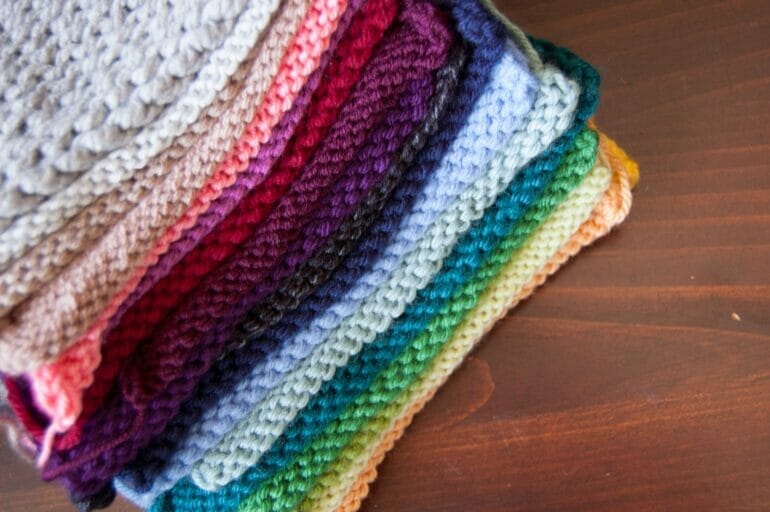Looking for a versatile and durable yarn for your clothing projects? Look no further than acrylic yarn! With its softness, affordability, and wide range of vibrant colors, acrylic yarn has become a popular choice for both beginners and experienced knitters and crocheters. Whether you’re creating cozy sweaters, scarves, or hats, acrylic yarn offers excellent stitch definition and easy care, making it a fantastic option for fashionable and long-lasting garments. Say goodbye to itchy and high-maintenance fabrics and embrace the versatility and comfort of acrylic yarn for your clothing creations.

Different Types of Acrylic Yarn for Clothing
Acrylic yarn is a synthetic fiber that is commonly used in the textile industry. It is known for its softness, durability, and versatility, making it a popular choice for various clothing applications. There are different types of acrylic yarn available, each with its own unique characteristics and advantages. In this section, we will explore some of the most common types of acrylic yarn used in clothing production.
1. Regular Acrylic Yarn
Regular acrylic yarn is the most basic type of acrylic yarn available. It is widely used in the production of clothing due to its affordability and ease of maintenance. Regular acrylic yarn is known for its softness and lightweight feel, making it comfortable to wear. It is also resistant to fading, stretching, and shrinking, ensuring that the clothing made from this yarn can withstand regular wear and washing. Regular acrylic yarn is available in a wide range of colors and is suitable for a variety of clothing items such as sweaters, hats, scarves, and blankets.
2. Anti-Pilling Acrylic Yarn
Anti-pilling acrylic yarn is specially treated to prevent the formation of pills, which are small, fuzzy balls that can form on the surface of fabric over time. This type of yarn is ideal for clothing items that are subject to frequent friction, such as socks, gloves, and sweaters. The anti-pilling treatment helps to maintain the smooth appearance of the fabric even after repeated use and washing. Anti-pilling acrylic yarn is available in various weights and can be used for both lightweight and heavy garments.
3. Chunky Acrylic Yarn
Chunky acrylic yarn is a thicker, heavier yarn that is commonly used for winter clothing and accessories. It is known for its warmth and insulation properties, making it perfect for cozy sweaters, scarves, and hats. Chunky acrylic yarn creates a textured, bulky appearance, adding dimension to the finished garments. It is available in a range of colors and is easy to work with, making it a popular choice for both beginner and experienced knitters or crocheters.
4. Cotton Blended Acrylic Yarn
Cotton blended acrylic yarn combines the softness and breathability of cotton with the durability and ease of maintenance of acrylic. This blend creates a yarn that is ideal for clothing items that require both comfort and longevity. The cotton content adds a natural feel to the fabric, while the acrylic fibers provide strength and resistance to wear and tear. Cotton blended acrylic yarn is commonly used for summertime garments such as t-shirts, dresses, and lightweight sweaters.
5. Metallic Acrylic Yarn
Metallic acrylic yarn is a specialty type of acrylic yarn that contains metallic threads or fibers. This yarn is often used for adding an element of shimmer and sparkle to clothing items, making it popular for evening wear, costumes, and accessories. Metallic acrylic yarn is available in various colors and finishes, ranging from subtle hints of metallic sheen to bold, eye-catching metallic effects. It can be used on its own or combined with other types of yarn to create unique textures and visual effects.
6. Baby Acrylic Yarn
Baby acrylic yarn is specifically designed for sensitive baby skin. It is hypoallergenic and gentle, ensuring that it does not cause any irritation or discomfort. This type of yarn is soft, lightweight, and easy to care for, making it ideal for creating baby clothing, blankets, and accessories. Baby acrylic yarn is available in a variety of pastel colors and can be used for both knitting and crocheting projects.
In summary, acrylic yarn offers a wide range of options for clothing production. Whether you’re looking for affordability, durability, warmth, or a touch of shimmer, there is a type of acrylic yarn to suit your needs. Consider the specific characteristics and advantages of each type when selecting yarn for your next clothing project.

How to Care for Clothes Made from Acrylic Yarn
Acrylic yarn is a popular choice for clothing due to its affordability, softness, and easy care. Whether you have a cozy acrylic sweater or a stylish acrylic scarf, it’s important to know how to properly care for these garments to ensure their longevity and maintain their appearance. In this section, we will guide you through the steps on how to care for clothes made from acrylic yarn.1. Read the Care Instructions
Before diving into the care routine, it’s essential to check the care instructions provided by the manufacturer. The label on your garment will typically include specific guidelines for washing, drying, and ironing acrylic clothing. Make sure to follow these instructions to avoid any damage or shrinkage.2. Hand Washing
One of the safest ways to clean acrylic clothing is by hand washing. Fill a basin or sink with lukewarm water and add a mild detergent. Gently swirl the garment in the soapy water, ensuring all areas are thoroughly soaked. Avoid excessive rubbing or wringing as this can cause stretching or distortion of the yarn. After a gentle wash, rinse the garment with clean water until no soap residue remains. Squeeze out excess water without wringing and lay it flat on a clean towel. Roll the towel to absorb remaining moisture, then reshape the garment by laying it flat on a drying rack or towel.3. Machine Washing
If your acrylic clothing is labeled as machine washable, you can safely clean it using a washing machine. However, it’s crucial to use the delicate or gentle cycle, as harsh agitation can damage the yarn. Additionally, consider placing the garment inside a mesh laundry bag to prevent tangling or stretching. Use a mild detergent specifically designed for delicate fabrics and avoid using bleach or fabric softeners. Set the machine to a cold or lukewarm water temperature and select a low spin speed. Once the cycle is complete, remove the garment promptly and reshape it before drying.4. Drying
When it comes to drying acrylic clothing, air drying is the preferred method. Lay the garment flat on a clean towel or drying rack and reshape it to its original size and form. Avoid hanging acrylic clothing as it can stretch or lose its shape under its own weight. If you’re in a hurry, you can use a dryer on a low heat setting. However, be cautious and keep an eye on the garment to prevent overheating, as high temperatures can cause shrinkage or damage to the yarn. Remove the clothing from the dryer while it’s still slightly damp to avoid excessive wrinkling.5. Ironing and Steaming
Acrylic yarn has low heat resistance, so it’s important to avoid direct contact with hot irons. Instead, opt for a cool iron temperature or use a garment steamer to remove any wrinkles. Keep the iron or steamer a few inches away from the fabric and work in a gentle, sweeping motion to avoid scorching or melting the yarn.6. Storage
Proper storage is essential to maintain the quality of acrylic clothing. Always make sure the garment is clean and completely dry before storing it. Fold the item neatly and place it in a drawer or on a shelf away from direct sunlight, as prolonged exposure can cause fading. To prevent moth or insect damage, consider using mothballs, cedar chips, or lavender sachets in your storage area. Avoid using plastic bags, as they can trap moisture and lead to mold or mildew growth. In summary, caring for clothes made from acrylic yarn involves reading the care instructions, hand washing or machine washing on a delicate cycle, air drying or using a low heat setting in the dryer, ironing with a cool temperature or steaming, and proper storage. By following these steps, you can ensure your acrylic garments remain soft, vibrant, and in excellent condition for years to come.
Styling Tips for Clothes Made with Acrylic Yarn
Acrylic yarn is a popular choice for crafting clothes due to its affordability, durability, and versatility. Whether you have knitted or crocheted a beautiful sweater or scarf with acrylic yarn, you may be wondering how to style and care for these garments to ensure they look their best. In this section, we will provide you with some helpful styling tips to make your acrylic yarn creations stand out.
1. Layering for Versatility
One of the benefits of acrylic yarn is its ability to be layered. When styling your acrylic yarn clothing, consider layering it with other pieces to create interesting and unique looks. For example, you can pair a knitted acrylic sweater with a collared shirt underneath or drape a crocheted acrylic shawl over a simple dress. By layering, you can add depth and dimension to your outfit while also adapting to different weather conditions.
2. Accessorize with Contrasting Colors
Acrylic yarn comes in a wide range of vibrant and bold colors. Take advantage of this by accessorizing your acrylic yarn clothes with contrasting colors. For instance, if you have a neutral-colored acrylic cardigan, add a pop of color with a bright scarf or statement necklace. This will draw attention to your garment and create a visually appealing ensemble.
3. Mix Textures for Visual Interest
Another way to elevate your acrylic yarn clothes is by mixing different textures. Acrylic yarn can be paired with materials like denim, leather, or even lace to create a visually interesting contrast. For example, a crocheted acrylic top can be paired with a denim skirt or leather pants for a mix of casual and edgy style. Experiment with different textures to create unique and eye-catching outfits.
4. Proper Washing and Care
To keep your acrylic yarn clothes looking their best, it’s important to follow proper washing and care instructions. Acrylic yarn is generally machine washable, but it’s recommended to use a gentle cycle with cool water to prevent stretching or pilling. Avoid using harsh detergents or bleach, as they can damage the fibers. After washing, reshape your garment and lay it flat to dry to maintain its shape.
5. Embrace Wrinkles as a Style Element
Unlike natural fibers, acrylic yarn has a tendency to wrinkle. Instead of seeing this as a flaw, embrace the wrinkles as a style element. The textured appearance can add a touch of uniqueness and informality to your outfit. However, if you prefer a more polished look, you can use a steamer or iron on a low heat setting to remove the wrinkles.
6. Experiment with Different Silhouettes
Acrylic yarn is known for its ability to hold its shape, making it a great choice for experimenting with different silhouettes. Try creating oversized sweaters, fitted dresses, or flared skirts with your acrylic yarn to explore different styles. Play around with different patterns and designs to find the silhouettes that flatter your body shape and personal style.
By following these styling tips, you can make the most of the clothes made with acrylic yarn. Experiment with layering, colors, textures, and silhouettes to create unique and fashionable outfits. Remember to care for your acrylic yarn garments properly to ensure they stay in great condition for years to come. Enjoy the versatility and durability of acrylic yarn in your wardrobe!
Comparison: Acrylic Yarn vs. Other Types of Yarn for Clothing
Choosing the right type of yarn for clothing projects is essential in achieving the desired look, feel, and durability. Acrylic yarn is widely used in the textile industry due to its affordability, versatility, and easy-care properties. However, there are other types of yarn available, each with its own set of characteristics. In this section, we will compare acrylic yarn with other popular types of yarn for clothing.
1. Acrylic Yarn
Acrylic yarn is made from synthetic fibers, specifically polymerized acrylic fibers. It is known for its softness, lightweight nature, and excellent color retention. Acrylic yarn is often used for making sweaters, scarves, hats, and other garments due to its affordability and availability in a wide range of colors.
One of the main advantages of acrylic yarn is its durability. It can withstand frequent washing and drying without losing its shape or color. Acrylic yarn is also resistant to wrinkles, making it ideal for garments that need to maintain their appearance.
However, acrylic yarn has a few disadvantages compared to other types of yarn. It lacks the natural breathability of fibers like cotton or wool, which may cause discomfort when worn in warmer climates. Additionally, some people find acrylic yarn to be less soft and luxurious compared to natural fibers.
2. Cotton Yarn
Cotton yarn is derived from natural cotton fibers. It is known for its breathability, softness, and hypoallergenic properties. Cotton yarn is a popular choice for warm-weather garments, baby clothing, and accessories.
Compared to acrylic yarn, cotton yarn has excellent moisture absorption, keeping the body cool and comfortable in hot conditions. It is also biodegradable and environmentally friendly.
However, cotton yarn has its drawbacks. It tends to stretch and lose shape over time, especially when wet. Cotton garments may also require more care, as they can shrink if not washed and dried properly. Additionally, cotton yarn is usually more expensive than acrylic yarn.
3. Wool Yarn
Wool yarn is made from the fleece of sheep or other animals, such as alpacas, cashmere goats, or rabbits. It is known for its warmth, softness, and natural insulation properties. Wool yarn is commonly used for winter clothing, blankets, and accessories.
Compared to acrylic yarn, wool yarn provides superior warmth and insulation. It has the ability to regulate body temperature, keeping the wearer warm in cold weather and cool in warm weather.
However, wool yarn requires special care and is often more expensive than acrylic yarn. It may shrink or felt if not washed and dried properly. Some individuals may also find wool yarn to be itchy or irritating to the skin, requiring an additional layer or lining.
4. Blended Yarn
Blended yarn is a combination of different fibers, such as acrylic and wool or acrylic and cotton. This type of yarn offers the benefits of multiple fibers, resulting in a unique combination of characteristics.
Blended yarns can combine the softness and durability of acrylic with the natural breathability and warmth of wool or cotton. They are often used for a wide range of clothing projects, providing a balance of comfort, affordability, and ease of care.
Summary
When it comes to choosing yarn for clothing projects, the decision ultimately depends on personal preferences, budget, and the desired properties of the finished garment. Acrylic yarn offers affordability, easy care, and a wide range of colors, making it suitable for various projects. Cotton yarn provides breathability and softness, while wool yarn offers superior warmth and insulation. Blended yarns combine the advantages of different fibers to create unique characteristics. Consider the specific requirements of your project to make an informed choice and create clothing that meets your style and comfort needs.
FAQs
Is acrylic yarn good for clothes?
Yes, acrylic yarn is a popular choice for clothing due to its affordability, durability, and ease of care. It is also lightweight and has good color retention. However, it may not be as breathable as natural fibers and can feel less soft compared to materials like cotton or wool.
Conclusion
In conclusion, acrylic yarn is a versatile and popular choice when it comes to clothing. Its affordability and wide range of colors make it a go-to option for many knitters and crocheters. Acrylic yarn also has the advantage of being easy to care for, as it is machine washable and resistant to fading. While it may not have the same natural feel as other fibers, it offers durability and is suitable for both lightweight and heavier garments. Whether you are making sweaters, scarves, or hats, acrylic yarn provides the ideal balance of functionality and creativity.
In summary, choose acrylic yarn for clothing projects if you prioritize cost-effectiveness, vibrant color options, and low-maintenance care.
